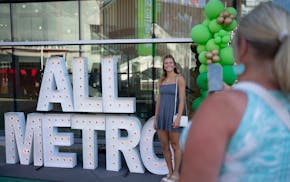Building height, blocked views, traffic and parking dominated a neighborhood discussion Wednesday of a development that would transform the intersection of Franklin and Lyndale Avenues.
Developer Don Gerberding has proposed constructing a six-story building containing apartments, ground-level retail and a theater at the busy but underdeveloped intersection. Anchoring his proposal is a 212-stall shared parking ramp that would accommodate both residential and public parking.
Such shared ramps remain fairly uncommon around Minneapolis, but more communities are eyeing them as a method to consolidate blighting surface parking lots. The development would replace two surface parking lots, one of which serves Rudolph's restaurant customers.
Several neighbors said at a Lowry Hill East Neighborhood Association Zoning and Planning committee Wednesday that they support having some development on the corner, but the proposed building is too tall. In particular, some complained it would block views of existing properties on Aldrich Avenue.
"It's way too high," said Helen Romanishan. "These people in the condos and the apartment buildings and the three houses…they're going to be in the dark."
Others observed that congestion in the area is already too problematic, spurring a discussion about biking, walking and transit.
"You're just increasing the population of our neighborhood," said Linda Huhn. "Why do we want to have more people? We already have so much traffic."
Another neighbor, Alan Poppe, countered that "people that live in this city don't always drive cars everywhere." He added that as a walker, he finds the current corner unfriendly for pedestrians "because there is no street life, there is really no streetscape."
Yet another resident, Paul Rucker, said project will increase congestion since many people are still using cars to get to jobs in the suburbs. "We do not have a public transit in this metro [area] that is currently able to handle the needs of people who have to go out and work in the suburbs," Rucker said.
Tom Olson observed that the Legislature is currently mulling a metro-area sales tax to fund transit. "I suggest everyone contact your local representative and hopefully we can mitigate some of these traffic problems at that intersection," Olson said.
Some residents expressed skepticism that the public parking would alleviate neighborhood parking pressures since it is not free. Gerberding said some businesses may offer validated parking, however.
"As you all know, Minneapolis people hate to pay for parking," said Deanna Hagg. "So if it's pay parking, is that going to push all of those people who don't want to pay for parking up to the" on-street neighborhood spots?
Hagg was more concerned, however, with the distance of the building from her condominium. "You'll be 13-feet max, with the parking garage, from my window," Hagg said.
Council Member Lisa Bender, who attended the meeting at Jefferson Elementary, noted to neighbors that the city has designated the node as an area for growth.
"Lyndale is a commercial corridor and Franklin is a community connector. They're on the transit priority network," Bender said. "So these are places we have identified for mixed-use, high density, medium-scale development."
She added that many of the variances for the project relate to the shared parking facility, which requires special exceptions under city rules.
"And that's a question: Do we as a community want to add 100 extra parking spaces here that are part of a district solution, that go beyond what is required by the uses that are in this building?" Bender asked.
Gerberding said 68 of the 212 parking stalls would be dedicated to the residential units, 61 stalls would be dedicated to retail uses and 83 would be left for general public parking.
Matt Brillhart, a Whittier resident and urbanism blogger, said the consolidation of surface parking lots would actually improve traffic.
"People talk about traffic, but I think the proposal will organize the traffic because we're taking multiple smaller parking lots, possibly reducing the number of curb cuts ... and organizing the flow of that traffic better," Brillhart said.
The Theater Garage, which currently occupies much of the site, will be incorporated into a below-grade structure in the new building. Some businesses will be displaced, including a dry cleaners, thrift shop and barber shop.

What to know about the latest COVID variants, Minnesota testing, vaccines
Sign up for Star Tribune newsletters

126 birds on list 'lost to science'

